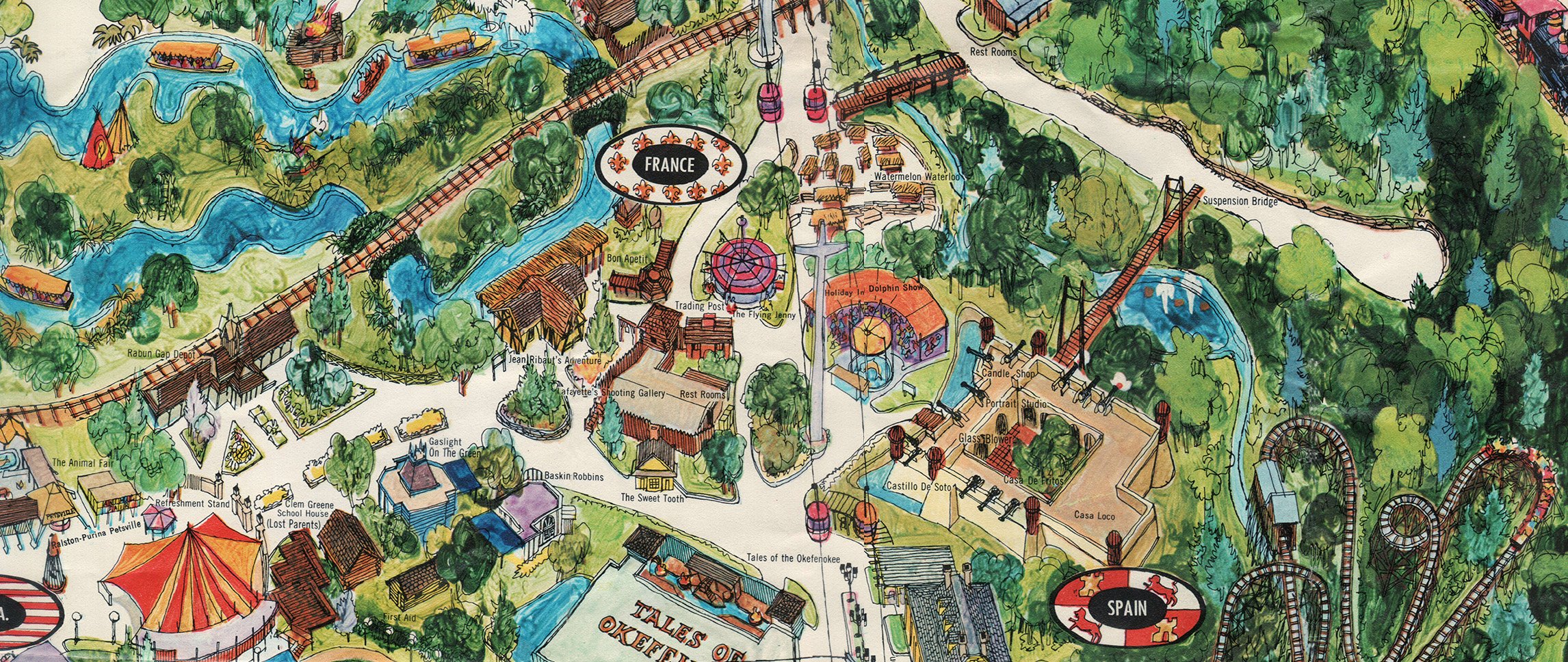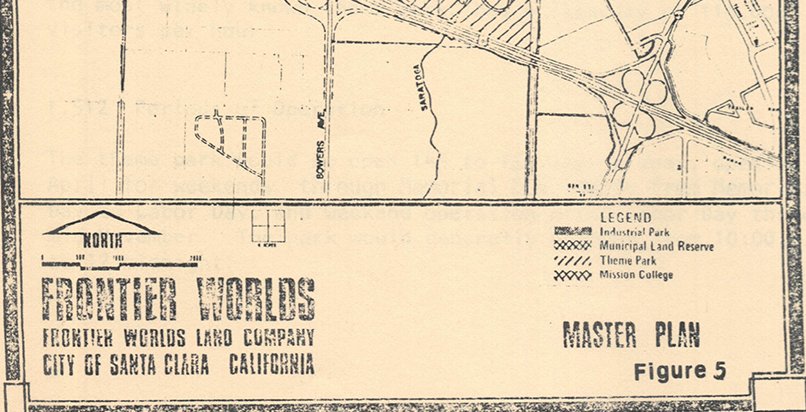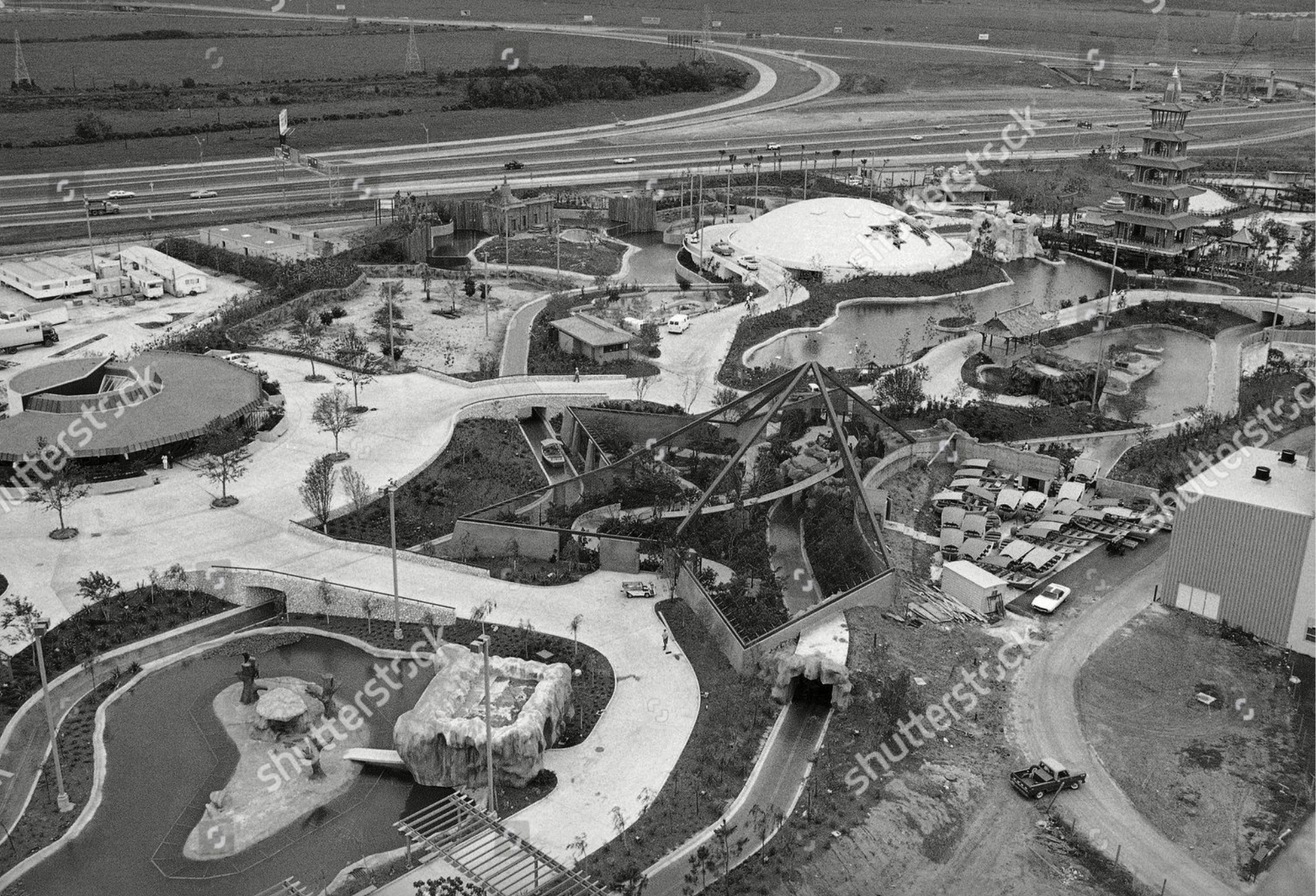
BUSCH GARDENS HOUSTON
Busch Gardens Houston was announced in 1969 and opened May 1971. Twenty-seven acres next to the brewery had been transformed by R. Duell & Associates into an $11 million park. The theme here was Asia, where the “Far East meets West,” nicely implemented in the architecture, landscaping, and selection of animals.
Towering over the park was the ornate Pagoda of Chin-wa-shwe; climb the stairs to a higher level for a panoramic view of the park. Head over to Hospitality House to sample the company’s products while your kids run ahead to the children’s area. There were few rides for kids (or for anyone, for that matter), but there was a Tree House that looked like it was from Bridge on the River Kwai, with two slides, one a bit smaller for younger children, along with a (short) swinging bridge. A tiny, unique Ferris wheel, built from thick wood-like beams and iron brackets, fit the theme quite well.
Circling this section of the park was the small scale Orient Express, chugging by Hidden Harbor, Sherpa Slide, and Rhino Land. The locomotive, designed to mimic 19th century steam trains used by the British in Asia, pulled beautifully detailed passenger cars featuring ornate iron work. The cheerful steam and whistle sounds could be heard throughout the park.
Houston was a bit more of a zoo than a garden, and so the animal enclosures were designed to reflect their native, natural surroundings as much as possible. The Bengals hung out in ancient Indian Temple of the Tiger ruins while the Ice Cave was home to polar bears, penguins, and sea lions. And there was lots more, with Orangutan Island, Elephant Compound, Macaque (monkey) Island, Camel Compound, Onager and Yak Compound, Flamingo Island, Bear and Tiger Cub Area, and Deer Park. A petting zoo got you up close and personal with a variety of fun creatures such as goats, lambs, and llamas, and the company’s trademark horses relaxed in the Clydesdale Stables.
All of this could be seen either from the footpaths that meandered around the property or by boat. These water-powered craft floated through the Ceylon Channel, cruising past the various animal islands and structures, through the Ice Cave and the bird aviary, and stopping along the way at the petting zoo. Don’t miss the bird show in the amphitheater, complete with oriental stage design, then pick up an Asian rice hat before heading over to the brewery for the tour.
The Duell touch was prominent in the beautiful architecture and thematic touches, and everything was nicely integrated. The architecture was certainly, for the most part, more thematically interesting and detailed than in the other Busch parks up to that point. Company officials had reason to be optimistic, basking in the success of their properties in California and Tampa. And so the gates swung open, ready for whatever was to come.
What that was, however, was unexpected. Although the Tampa park was an unqualified success as a gated attraction, the other two properties were already in trouble. Houston, opening from the get-go with an entrance fee of $2.25 for adults, never came close to expected attendance of 800,000 for 1971. The following year was no better in spite of their efforts, and so during the 4th financial quarter of 1972 they announced the park would become a promotional facility, like what Los Angeles had started out. Busch admitted the park was never profitable, and with the significant costs of maintaining the animals it was too much to bear. After only two seasons the gardens in Houston closed for good, incurring a $5 million accounting charge to do the conversion.
Meanwhile, over at Los Angeles things were also beginning to unravel. The conversion to a gated park in 1972 included a $6 million, five acre expansion across the railroad tracks, then in 1975 a second major upgrade saw an Old St. Louis section and an elevated monorail that toured the park (the original concept art for the monorail was spectacular, designed to mimic an ornate turn-of-the-century streetcar...the Sky Trolley that arrived on property didn’t come close). For a short while the future looked bright enough, but the changeover to a gated park began to stifle attendance. Operating costs were fairly high with the rides, labor, and insurance, and the company never recouped their investment. So in 1977, after losing another $5 million the previous year, Busch gave up on the amuse‐ ment side of things and converted the park back to a free-of-charge gardens promotional facility. This moved expenses over to the corporate advertising budget, allowing the entertainment division to flourish in Tampa and the new park in Virginia. With a reduced staff of 17, down from 45, the new Busch Bird Sanctuary focused on its famous gardens and tropical birds, becoming an officially sanctioned nature preserve. And of course the free beer flowed as always.
What went wrong with both of these properties, especially considering how well the Tampa park was doing? Were the gardens beautiful? Oh yes. Busch spent millions creating paradise in the middle of industrial zones. Were they serious amusement parks? Hardly, not with the likes of Disneyland, Knott’s, Magic Mountain, and Astroworld close by. Both locations were seriously site-constrained with no more room to grow. Over time the allure of a simple boat ride and monorail tour of the brewery just couldn’t compete. There were hardly any thrill rides in Van Nuys, none at all in Houston, and presumably families considered the ticket prices too expensive with not enough to do. Attractions must continually evolve in order to generate repeat business, something the Tampa location was able to do with ample land and a better connection with guests for whatever reasons. At any rate, not enough people showed up, and that was that.
Images from:

















